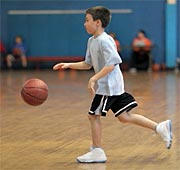- Skip Storing This Everyday Product in the Fridge Door
- Green Tea + B3 Pairing May Boost Brain Health
- Navigating Your Midlife Crisis: Embracing New Possibilities
- City Raccoons Showing Signs of Domestication
- Mapping the Exposome: Science Broadens Focus to Environmental Disease Triggers
- One Week Less on Social Media Linked to Better Mental Health
- Your Brain Changes in Stages as You Age, Study Finds
- Some Suicide Victims Show No Typical Warning Signs, Study Finds
- ByHeart Formula Faces Lawsuits After Babies Sickened With Botulism
- Switch to Vegan Diet Could Cut Your Greenhouse Gas Emissions in Half
Kids Worldwide Getting Less Heart Fit, Research Shows


Children across the globe can’t run as far or as fast as their parents did at their age, according to new research.
In a one-mile footrace, a kid today would finish a minute and a half behind a typical child from 1975, said study lead author Grant Tomkinson, a senior lecturer in the University of South Australia’s School of Health Sciences.
“We all live in an environment that’s toxic for exercise, and our children are paying the price,” Tomkinson said.
Children today are about 15 percent less aerobically fit than their parents were as youngsters, Tomkinson and his colleagues discovered. In the United States it’s even worse — kids’ heart endurance fell an average 6 percent in each of the three decades from 1970 to 2000.
These levels of fitness in childhood will more than likely result in worse health in adulthood, Tomkinson said. Kids will have weaker hearts and thinner bones, and an overall lower quality of life.
Tomkinson is scheduled to present his findings Tuesday at the American Heart Association’s annual meeting in Dallas.
Sam Kass, executive director of Michelle Obama’s Let’s Move! initiative, called the results of the one-mile cross-generational footrace “shocking.”
“It’s clear over the last four decades we’ve been in a cycle of inactivity, and that’s leading to some devastating health outcomes,” Kass said.
The researchers came to their estimates by analyzing 50 studies on running fitness between now and 1964 that involved more than 25 million kids aged 9 to 17 in 28 countries.
Studies included in their analysis measured heart endurance by how far kids could run in a set time or how long it took them to run a set distance. Tests usually lasted five to 15 minutes or covered between a half-mile and two miles of running.
Endurance declined significantly over the years, but in ways that were similar between boys and girls and younger and older kids across different regions of the globe.
Because this study was presented at a medical meeting, the data and conclusions should be viewed as preliminary until published in a peer-reviewed journal.
Tomkinson said there are many factors that have combined to create an increasingly inactive society, including the following:
- Communities designed to discourage walking, bicycling and backyard play. “We have to travel farther to get to parks and green spaces, and they may not always be of the best quality,” he said. “Kids are less likely to ride bikes or walk to school.”
- Schools that have either rid themselves of physical education or replaced it with a less strenuous version of the class. These days, only 4 percent of elementary schools, 8 percent of middle schools and 2 percent of high schools offer a daily physical education class, Kass said.
- The prevalence of TV, computer, tablet and smartphone screens that sap a kid’s will to venture outdoors.
Obesity also plays a part. “We are fatter today, so from a weight-bearing perspective it’s harder to move our bodies through space,” Tomkinson said, noting that about 30 percent to 60 percent of declines in endurance running performance can be explained by increases in body fat mass.
So what’s the solution? To Tomkinson, it’s simple — kids need to be exposed to prolonged exercise that leaves them exhausted.
“You want exercise to be fun, but there needs to be some huff and puff there as well,” he said. “It needs to make them somewhat tired.”
Kids need to engage in at least 60 minutes of physical activity that uses the body’s big muscles, like running, swimming or cycling, Tomkinson said.
It doesn’t have to be all at once, however. Tomkinson said kids can “snack” on physical activity throughout their day — engaging in a walk for 10 minutes in the morning, or playing an active game for 10 minutes at recess, for example.
Parents also need to engage with their kids, he added. They should limit a kid’s sedentary time to no more than two hours a day, while also exposing them to a range of physical activities they might enjoy.
Kass of Let’s Move! called on Americans to work toward making physical activity easier and more fun, both for children and adults.
“We know we need to break this cycle of passing physical inactivity down from one generation to the next,” Kass said. “There’s no one solution. It’s got to happen in a comprehensive way. We have to integrate physical activity in our lives. It’s got to be a part of our daily lives.”
More information
For more about kids and physical activity, visit Let’s Move!
Source: HealthDay
Copyright © 2025 HealthDay. All rights reserved.










